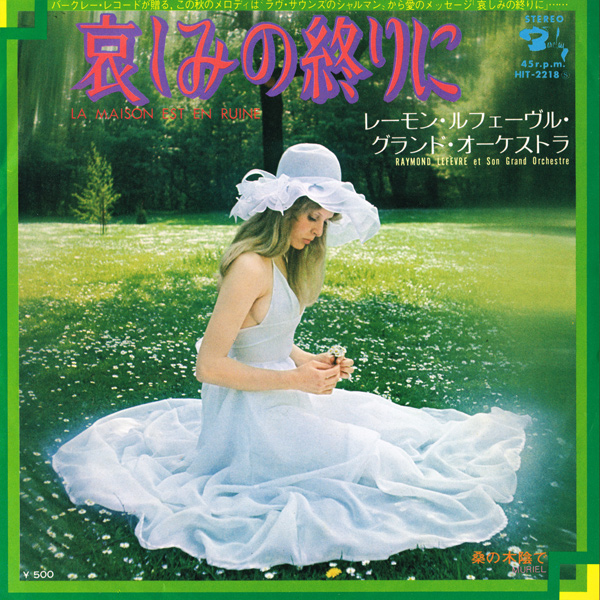45 R.P.M.: LA MAISON EST EN RUINE

HIT-2218 S, King Record Co. Ltd., Japan. P '75-8. Recorded in France. A Riviera Production / Barclay (France)
- La Maison est en Ruine (3:08) (M. Delpech, J.M. Rivat, C. Morgan)
- Muriel (2:20) (R. Lefèbvre)
SLEEVE NOTES:
In the past few years, the rise of so-called "French pop music" has been remarkable, and Paul Mauriat, Franck Pourcel, and Raymond Lefèvre, who can be called the "three greats" in this field, have been very popular in the record market. There are many reasons for their success, but I don't think anyone would disagree that one of them is their interesting arrangements. The easiest way to find out the secret is to listen to the records of each of the three groups and compare them with each other. If I were to describe the characteristics of their sound in a few words, I would say that Mauriat is sharp, Pourcel is calm, and Lefèvre is warm.
The technique shared by all three musicians is to skillfully place strings on top of a solid rhythm, and our own Mr. Lefebvre's technique is very orthodox and unaffected. Compared to the sound of Mauriat's amplified violin, I felt that it was a bit lacking. Of course, this is what we, as experts in the field, have been listening to carefully and with a mean streak, but it is a very simple and straightforward statement. So, then, how is it that the strings give such a brilliant, sometimes thrilling, dynamic impression? Well, listen to some of the songs again as you read this ramble. See, do you hear a chirping sound behind the strings? Listen carefully. See? See?
If someone casually says, "Oh, it's the xylophone, the glockenspiel, the stringed guitar, and the harpsichord all playing together, plus the tambourine..." If you casually say, "Oh, it's a combination of xylophone, glockenspiel, stringed guitar, and harpsichord, and a tambourine," you have the ear of a professional. You can be an arranger tomorrow. Yes, this is the secret of Lefebvre. The percussion instruments played casually are the seasoning, seasoning the strings like a plain, but high quality Kobe meat, and the whole thing is ready to go. And Lefebvre's sound, compared to the other two, somehow has a distinctly southern European flavor. It is strange that he, who was born in northern France, can produce a southern European sound, but perhaps this is due to the fact that he and Dalida had been working together for a long time. I was surprised to hear his original "Muriel," and wondered if it was really the same person. There was a totally different world of sound there. I am sorry, but it seems that his sound is hard to describe in a single word. I am sorry to say that it is difficult to describe his sound in a few words, but I respect him very much, because he is 46 years old and still not frozen up.
"La Maison est en Ruine" was written by Michel Delpech and Jean-Michel Riva, two great French pop stars known for their big hits "Wight is Wight" and "Pour un Flirt," and composed by Claude Morgan, who also wrote "Tu te reconnaîtras," the winner of the 1973 Eurovision Contest. Composed by Claude Morgan.
"Muriel" is by Lefèvre himself.
Katsuhisa Hattori
Note: Translation made by online translator.
